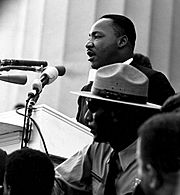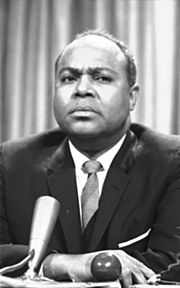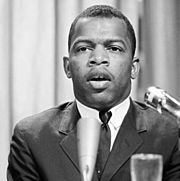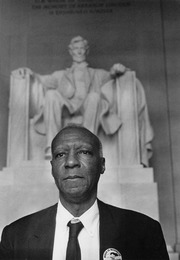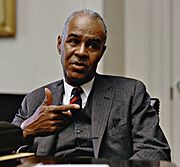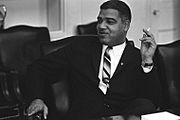Big Six (activists) facts for kids
The Big Six were six important leaders during the Civil Rights Movement in the United States. They were Martin Luther King Jr., James Farmer, John Lewis, A. Philip Randolph, Roy Wilkins, and Whitney Young. These leaders were very important in organizing the famous March on Washington for Jobs and Freedom in 1963. This march was a major event during the fight for equal rights.
James Farmer, in his book Lay Bare the Heart, explained that the term "Big Six" came from the creation of the Council for United Civil Rights Leadership. He mentioned that sometimes the press called them the "Big Four." This was because they often left out Dorothy Height (who Farmer included as a sixth member) and John Lewis. Farmer believed this was due to unfair reasons like sexism and age.
A journalist named Patrick Henry Bass wrote about how these leaders became well-known. He said they lived in two worlds. One was the political world, where they were becoming more familiar with how things worked. The other was the Black community, where they were seen as part of the family.
About two months before the March on Washington, the Big Six decided to work with four white men who supported their cause. These men were Walter Reuther, Eugene Carson Blake, Mathew Ahmann, and Joachim Prinz. Together, the Big Six and these four new members became known as the "Big Ten."
Contents
The Big Six Leaders
Martin Luther King Jr.
Martin Luther King Jr. (born January 15, 1929 – died April 4, 1968) was a Baptist minister and a very important leader of the Civil Rights Movement. He was the chairman of the Southern Christian Leadership Conference (SCLC). King believed strongly in nonviolence and racial equality.
He won the Nobel Peace Prize in 1964. After he was assassinated in 1968, he was given the Presidential Medal of Freedom in 1977. Many people around the world see him as a peacemaker. In the United States, we celebrate Martin Luther King Jr. Day in his honor. There is also a Martin Luther King Jr. Memorial on the National Mall in Washington, D.C.
James Farmer
James Farmer (born January 12, 1920 – died July 9, 1999) started the Congress of Racial Equality (CORE) in 1942. CORE was a group that believed in achieving racial harmony and equality through peaceful protests. Farmer was chosen as its first national director in 1953.
When his supporters asked him, "When are you going to fight back?" Farmer replied, "We are fighting back, we're only using new weapons." His ideas led to important actions like sit-ins and the Freedom Rides. These actions challenged segregation in places like restaurants and on buses. CORE gained national attention, and many people volunteered to join. Farmer felt that this growth of volunteers was his greatest achievement.
Farmer was unable to attend the 1963 March on Washington. He was held by authorities in Louisiana due to his protest activities. In 1998, he received the Presidential Medal of Freedom for his work during the Civil Rights Movement. He passed away in 1999.
John Lewis
John Lewis (born February 21, 1940 – died July 17, 2020) became a leader in the Civil Rights Movement as president of the Student Nonviolent Coordinating Committee (SNCC). He also took part in the Nashville Student Movement. Lewis was one of the first 13 Freedom Riders.
While in college, he participated in sit-ins at segregated restaurants. These sit-ins inspired similar protests across the country. At 23 years old, Lewis was the youngest member of the Big Six to speak at the March on Washington on August 28, 1963.
Lewis later represented the 5th District of Georgia in the United States House of Representatives from 1987 until his death. He received the Profile in Courage Award in 2001 and the Presidential Medal of Freedom in 2010. He was the last surviving member of the Big Six.
A. Philip Randolph
A. Philip Randolph (born April 15, 1889 – died May 16, 1979) was a leader in both the labor movement and the Civil Rights Movement. In 1925, he started the Brotherhood of Sleeping Car Porters. This was the first major effort to create a labor union for employees of the Pullman Company. The Pullman Company was a big employer of African Americans.
During World War II, Randolph played a key role in the March on Washington Movement. Although this movement did not lead to an actual march at that time, it helped to integrate war industries and later the armed forces.
Roy Wilkins
Roy Wilkins (born August 30, 1901 – died September 8, 1981) was an important civil rights activist from the 1930s to the 1970s. In 1955, he became the executive director of the National Association for the Advancement of Colored People (NAACP). He was known as an excellent spokesperson for the Civil Rights Movement.
He participated in several important events. These included the March on Washington in 1963, the Selma to Montgomery marches in 1965, and the March Against Fear in 1966.
Whitney Young
Whitney Young (born July 31, 1921 – died March 11, 1971) spent most of his career fighting to end employment discrimination in the South. His own experiences with discrimination during World War II inspired him.
In 1961, Young was chosen as the executive director of the National Urban League. He held this position until his death in 1971. As director, he transformed the National Urban League. He made it a group that actively fought for justice. He did this by introducing new educational programs that also included white members of the league.


